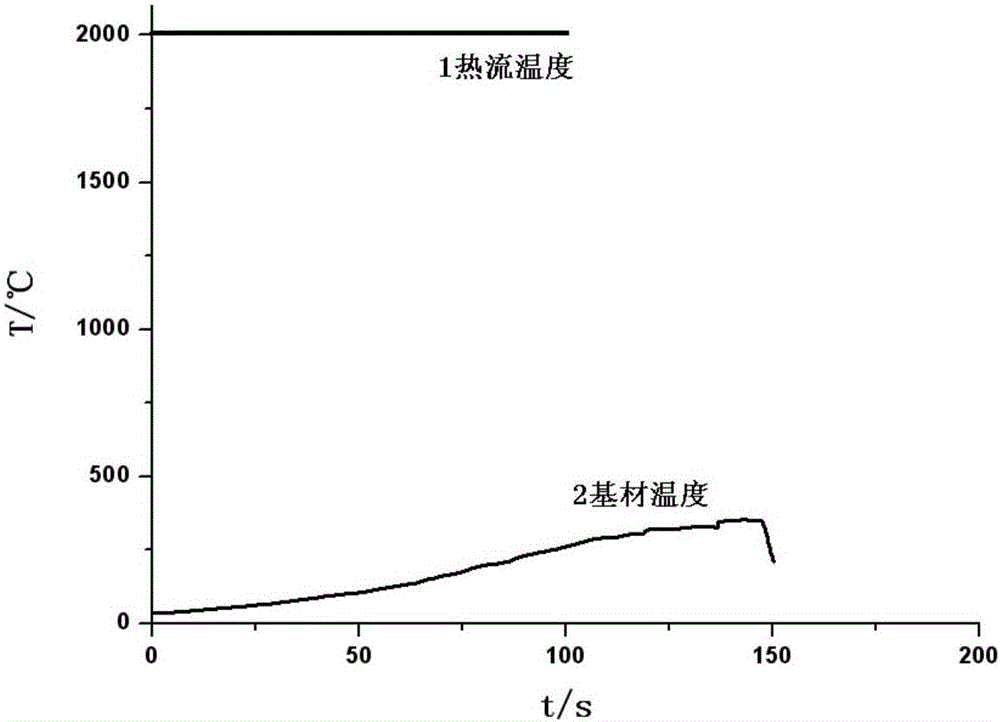Short-term high-temperature ablation resistant protective coating and preparation method thereof
A protective coating and high temperature resistance technology, applied in the field of surface engineering, can solve problems such as high temperature cracking of phenolic coatings, and achieve the effects of reducing the surface temperature of the substrate, simple preparation process, and short-term high temperature ablation effect.
- Summary
- Abstract
- Description
- Claims
- Application Information
AI Technical Summary
Problems solved by technology
Method used
Image
Examples
Embodiment 1
[0032] 1) Add 100g of barium phenolic resin, 100g of high silica fiber, and 25g of phenolic pellets in sequence using high-speed shear dispersion equipment and mix them evenly;
[0033] 2) Molded coating preparation: take 100g and put it into the cavity of the flat steel mold on the surface of the carbon / carbon substrate, the size of the flat steel mold is 100mm×100mm×5mm;
[0034] 3) Place the carbon / carbon substrate together with the mold in a flat press to press it into a flat plate with a pressure of 1 ton. After standing at room temperature for 24 hours, it is cured in a flat press at 160°C and a pressure of 1 ton for 5 hours to obtain a coated carbon / carbon substrate. carbon substrate.
[0035] The obtained coated carbon / carbon substrate was subjected to a thermal ablation test, ablated with a plasma flame at 2000°C for 100s, the coating was not completely ablated, the substrate temperature was ≤360°C, and the substrate temperature was as follows: figure 1 As shown, and...
Embodiment 2
[0037] 1) Add 100g of boron phenolic aldehyde, 80g of viscose carbon fiber, 25g of cork powder, and 25g of phenolic pellets in sequence using a three-roller grinding equipment and mix them evenly, and control the distance between the rollers of the three-roller grinding equipment to 1-1.5mm;
[0038] 2) Stir a certain amount of acetone evenly in the uniformly dispersed material to prepare the coating, the amount of acetone added is determined according to the viscosity of the coating, and the viscosity is 10-30s measured with a Tu-4 cup viscometer;
[0039] 3) At room temperature, spray the paint on the surface of the carbon / carbon substrate with a spray thickness of 6mm. After standing at room temperature for 24 hours, it is cured at 160°C for 5 hours to obtain a coated carbon / carbon substrate.
[0040] Coating effect: The coating is ablated with a plasma flame at 2000°C for 100s, the coating is not completely ablated, and the substrate temperature is ≤320°C.
Embodiment 3
[0042] 1) Add 100g of ammonium phenolic resin, 50g of epoxy E51 resin, 150g of high silica fiber, and 50g of phenolic pellets in sequence using high-speed shear dispersion equipment and mix them evenly;
[0043] 2) Molded coating preparation: add 10g polyamide to the uniformly mixed material, take 100g after stirring evenly and put it into the cavity of the flat steel mold on the surface of the carbon / carbon substrate, the size of the flat steel mold is 100mm ×100mm×5mm;
[0044] 3) Place the carbon / carbon substrate together with the mold in a flat press to press it into a flat plate with a pressure of 1 ton. After standing at room temperature for 24 hours, it is cured in a flat press at 160°C and a pressure of 1 ton for 5 hours to obtain a coated carbon / carbon substrate. carbon substrate.
PUM
| Property | Measurement | Unit |
|---|---|---|
| density | aaaaa | aaaaa |
Abstract
Description
Claims
Application Information
 Login to View More
Login to View More - R&D
- Intellectual Property
- Life Sciences
- Materials
- Tech Scout
- Unparalleled Data Quality
- Higher Quality Content
- 60% Fewer Hallucinations
Browse by: Latest US Patents, China's latest patents, Technical Efficacy Thesaurus, Application Domain, Technology Topic, Popular Technical Reports.
© 2025 PatSnap. All rights reserved.Legal|Privacy policy|Modern Slavery Act Transparency Statement|Sitemap|About US| Contact US: help@patsnap.com

